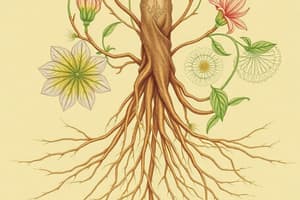Podcast
Questions and Answers
What is the primary focus of the branch of biology known as botany?
What is the primary focus of the branch of biology known as botany?
- The study of microorganisms
- The study of plant biology (correct)
- The study of animal behavior
- The study of geological formations
Which subdivision of botany studies the structure and organization of plants?
Which subdivision of botany studies the structure and organization of plants?
- Ethnobotany
- Plant Physiology
- Plant Anatomy (correct)
- Plant Ecology
Which process describes the conversion of light energy into chemical energy in plants?
Which process describes the conversion of light energy into chemical energy in plants?
- Respiration
- Fertilization
- Photosynthesis (correct)
- Transpiration
What type of plants are considered vascular plants?
What type of plants are considered vascular plants?
Which type of reproduction involves the formation of seeds through pollination and fertilization?
Which type of reproduction involves the formation of seeds through pollination and fertilization?
What is a significant factor that influences plant growth and development?
What is a significant factor that influences plant growth and development?
Which kind of plants are classified as gymnosperms?
Which kind of plants are classified as gymnosperms?
What do auxins, gibberellins, and cytokinins have in common?
What do auxins, gibberellins, and cytokinins have in common?
Flashcards are hidden until you start studying
Study Notes
Definition of Botany
- Branch of biology focused on the study of plants.
- Includes growth, reproduction, metabolism, development, diseases, and taxonomy of plants.
Subdivisions of Botany
- Plant Anatomy: Study of plant structure and organization.
- Plant Physiology: Examines the functions and processes of plants.
- Plant Ecology: Investigates the relationships of plants with their environment.
- Plant Taxonomy: Classification and naming of plants.
- Ethnobotany: Study of the relationship between people and plants.
Importance of Botany
- Provides understanding of plant biology crucial for agriculture, horticulture, and forestry.
- Essential for biodiversity conservation and understanding ecosystems.
- Contributes to medicine through the study of medicinal plants.
Plant Classification
- Kingdom Plantae: Divided into various groups based on characteristics.
- Non-vascular plants: Mosses and liverworts.
- Vascular plants: Includes ferns, gymnosperms, and angiosperms.
- Gymnosperms: Seed-producing plants without flowers (e.g., pine trees).
- Angiosperms: Flowering plants that produce seeds within fruit.
Plant Processes
- Photosynthesis: Conversion of light energy into chemical energy; occurs in chloroplasts.
- Respiration: Process by which plants convert glucose and oxygen into energy, releasing carbon dioxide.
- Transpiration: Movement of water through plants and its evaporation from aerial parts.
Plant Reproduction
- Asexual Reproduction: Involves vegetative methods (e.g., cuttings, runners).
- Sexual Reproduction: Involves the formation of seeds through pollination and fertilization.
Plant Growth & Development
- Growth Factors: Light, water, nutrients, temperature, and hormones.
- Hormones: Auxins, gibberellins, cytokinins, and abscisic acid regulate growth and development.
Common Plant Diseases
- Caused by pathogens (bacteria, fungi, viruses).
- Symptoms include wilting, discoloration, and stunted growth.
Conservation and Sustainability
- Importance of preserving plant diversity for ecological balance.
- Practices include sustainable agriculture, habitat restoration, and the establishment of protected areas.
Current Trends in Botany
- Advances in genetic engineering and biotechnology.
- Research on climate change impacts on plant species and ecosystems.
- Exploration of plant-based solutions for sustainability issues.
Definition of Botany
- Focuses on the biological study of plants, encompassing their growth, reproduction, metabolism, development, diseases, and classification.
Subdivisions of Botany
- Plant Anatomy: Analysis of the structure and organization of various plant parts.
- Plant Physiology: Investigation of the functions and biochemical processes in plants.
- Plant Ecology: Study of the interactions between plants and their environment.
- Plant Taxonomy: Process of classifying and naming different plant species.
- Ethnobotany: Exploration of how plant use is interwoven with human cultures and practices.
Importance of Botany
- Critical for advancing agriculture, horticulture, and forestry practices.
- Essential for conserving biodiversity and understanding ecological systems.
- Vital for discovering and utilizing medicinal properties of plants.
Plant Classification
- Kingdom Plantae: Comprised of diverse groups based on shared characteristics.
- Non-vascular plants: Includes species like mosses and liverworts that lack vascular systems.
- Vascular plants: Comprises ferns, gymnosperms, and angiosperms, characterized by vascular tissue.
- Gymnosperms: Seed plants that do not produce flowers, such as pine trees.
- Angiosperms: Flowering plants that produce seeds encapsulated in fruit.
Plant Processes
- Photosynthesis: Process where plants convert light energy into chemical energy using chloroplasts.
- Respiration: Conversion of glucose and oxygen into energetic resources, producing carbon dioxide as a byproduct.
- Transpiration: Mechanism of water movement through plants, culminating in evaporation from leaves and stems.
Plant Reproduction
- Asexual Reproduction: Involves means such as cuttings or runners to propagate plants without seeds.
- Sexual Reproduction: Requires pollination and fertilization, leading to seed formation.
Plant Growth & Development
- Growth Factors: Key elements for plant growth include light, water, nutrients, temperature, and hormonal influences.
- Hormones: Regulatory substances like auxins, gibberellins, cytokinins, and abscisic acid play critical roles in growth and development processes.
Common Plant Diseases
- Diseases caused by pathogens including bacteria, fungi, and viruses.
- Symptoms manifest as wilting, discoloration, and stunted growth in infected plants.
Conservation and Sustainability
- Preserving plant diversity is crucial for maintaining ecological balance.
- Sustainable practices encompass organic farming, habitat restoration, and creating protected areas for conservation.
Current Trends in Botany
- Significant advances are occurring in genetic engineering and biotechnology applications in plant sciences.
- Ongoing research focuses on the impacts of climate change on plant species and ecosystems.
- Exploration of plant-based solutions to address sustainability challenges facing the planet.
Studying That Suits You
Use AI to generate personalized quizzes and flashcards to suit your learning preferences.




